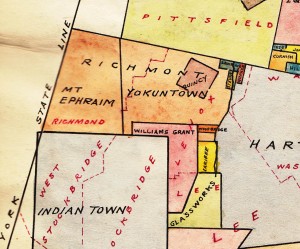Lenox Land Grants

The land that would comprise Lenox and Richmond was auctioned as Lot 8 by the Royal Colony General Court in 1762. But, the land that was being auctioned for what would become Lenox was only about half the total acerage – the rest had already been bought or distributed as grants. The Indians believed themselves to be holders of most of the rest. Here is a brief description of the situation at the time of the Lot 8 auction.
1. The Ministers Grant (~4,000 acres)* –
Mohegan Sachem Konkaput had given a Dutch interpreter quite a few acres of meadowland along the river in Stockbridge. Then the interpreter fell into debt, and borrowed 100 pounds from John Sergeant (the Stockbridge Minister) with land as security. The Dutchman then sold, for 450 pounds, to a group that offered to trade (finalized in 1741-1742) 280 acres of this land for 4,000 acres of woodland to the north east (Lenox). The group consisted of: Ephraim Williams – 900 acres plus a 130 acre pond, Nehemiah Bull 700 acres; and the remainder to Stephen Williams, Samuel Hopkins, John Sergeant, Timothy Woodbridge, Jonathan Edwards (John Stoddard’s nephew) and Peter Reynolds.
In my opinion a group of pretty sharp operators.
By the time Lenox was officially established, a number of these grants had been passed to heirs.
2. Grants from the Royal Colony in Recognition of Service to the State (~2500 Acres)
- The Quincy Grant – In 1737 Edmund Quincy was appointed to a commission to resolve the Massachusetts border with New Hampshire and he traveled to London on this mission where he contracted smallpox and died. In return for his service his family was, in 1739, awarded 1,000 acres in what would become Lenox.
- The Larrabee Grant – 500 acres in 1739 to Capt . John Larrabee for service and expense of managing Fort William (Boston Harbor.) The grant comprises much of what would become Lenox Furnace/ Lenox Dale.
- The Stevens Grant – 250 acres in 1756 for the support of the widow and children of Capt. Phineas Stevens. Capt. Stevens had, with 30 militia men, held off put to 700 French and Indians during King George’s War, at Fort Number 4 – the northernmost British outpost on the Connecticut River in modern day Charleston, NH, on the border with modern day Vermont.
- The Lawrence Grant – 353 acres granted in 1758 to compensate for land given to New Hampshire when the new border was drawn.
- The Woodbridge Grant – In 1759, some of the Stockbridge Indians, lead by Jehoiakim Yokun, granted Timothy Woodbridge 350 acres in gratitude for his services as schoolmaster.
3. Indian Claims on the remaining land – estimate roughly 6,000-7,000 additional acres – The King viewed all unclaimed land as his to dispense or sell, but the Royal Colony had accepted the appropriateness of treating the land as a “purchase” from the Indians for the sake of peace. Purchase is in quotes here because, in most cases, the purchase price was heavily discounted to ceremonial. In the case of Lenox, the Indian land claims were actively defended. Perhaps the Indians realized values were going up as the land was cleared and settled. In the early days of the Stockbridge reservation (1739-1745) Jehoiakim Yokun and another Indian bought all the unsold land between Stockbridge and Pittsfield from fellow tribesmen for 12 pounds. He and other principal families claimed land throughout western Massachusetts (p. 52)* . It is not know This may be the man for whom “Yokuntown” (Lenox) was originally named.
The Indians had clearly learned a thing or two from their sharp dealing English allies since, by 1761, it took three escalating offers, to get the Indians to sell the lands they held in Lenox.
Net: The buyers of Lot 8 weren’t dealing with untouched territory. Clarifying existing property lines, establishing titles and dealing with households that may have settled without title would have been complicated and expensive. It’s not completely clear whether these costs would have been bourne by the buyers (the proprietors) or the sellers (the Royal Colony government.) Undoubtedly, as in modern real estate transactions, there would have been a need for individuals wit the contacts and expertise to work the government angle, the property law angle and negotiate with sellers ranging from Indians to competitive English landowners. Probably the successful fixers were well connected and good at skating on the edge of what would be considered ethical by modern standards.
*The Mohicans of Stockbridge, Patrick Frazier, University of Nebraska Press, 1992
Also see:
George Tucker Manuscript: A History of Lenox
Middle County Berkshire Registry of Deeds, Colonial Records
